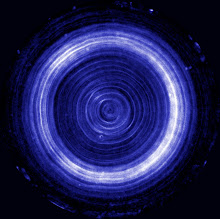Following his successful work in the pyramid, Reid built a prototype "CymaScope" consisting of a simple latex membrane with the facility to tune its tension, excited by a conventional transducer. In 2005 he was introduced to Erik Larson who took Reid's prototype and precision engineered it, building in many enhancements. Realizing that their early work with exciting particulate media could not yield sufficient detail, they explored the use of water as the membrane.
In its present evolutionary stage the CymaScope can make visible any sound in a bandwidth extending from 3 Hz to 1000 Hz. An experimental high frequency WaterDrive Module can extend this to 3,000 Hz. The resulting images represent an analog of the frequencies present in the sound, a kind of 'fingerprint' of a given sound, that can be photographed and videographed for close study.


No comments:
Post a Comment